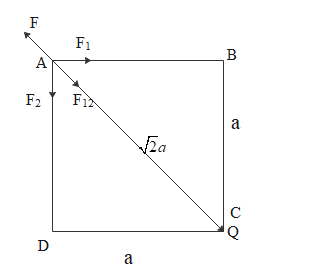Answer
346.8k+ views
Hint: First of all read the question carefully and understand the values or quantities given in the question. Also observe the diagram carefully. After that apply Coulomb’s law. Since the two forces are acting at right angles we must calculate the resultant force. Then equate it with the force due to Q. Thus by rearranging and substituting the values we get the value of q.
Complete step-by-step solution:
Let the side of the square be ‘a’. Then by Pythagoras theorem the diagonal of the square is $\sqrt{2}a$.
Thus the force due to the charge Q at A and C is,
$F=\dfrac{1}{4\pi {{\varepsilon }_{0}}}\dfrac{{{Q}^{2}}}{2{{a}^{2}}}$
And the direction of this force is outward.
Hence in order to become the net force to zero, the force ${{F}_{1}}$ on Q due to q must be equal to the force ${{F}_{2}}$ on Q due to q.
Thus,
${{F}_{1}}={{F}_{2}}=\dfrac{1}{4\pi {{\varepsilon }_{0}}}\dfrac{Qq}{{{a}^{2}}}$
As ${{F}_{1}}$and ${{F}_{2}}$are at right angles.
${{F}_{12}}=\dfrac{1}{4\pi {{\varepsilon }_{0}}}\dfrac{\sqrt{2}Qq}{{{a}^{2}}}$
For the equilibrium condition of Q,
$F={{F}_{12}}$
$\dfrac{1}{4\pi {{\varepsilon }_{0}}}\dfrac{{{Q}^{2}}}{2{{a}^{2}}}=\dfrac{1}{4\pi {{\varepsilon }_{0}}}\dfrac{\sqrt{2}Qq}{{{a}^{2}}}$
$\Rightarrow \dfrac{Q}{2}=\sqrt{2}q$
We have to find q. Hence rearranging and substituting the values we get,
$q=\dfrac{Q}{2\sqrt{2}}$
$\therefore q=\dfrac{\sqrt{2}\mu C}{2\sqrt{2}}=0.5\mu C$
Note:Remember that the resultant force is the difference in the magnitude of larger force to the smaller force. If the two forces have the same magnitude and if they are acting just in the opposite direction to one another then the resultant force is zero.
Complete step-by-step solution:
Let the side of the square be ‘a’. Then by Pythagoras theorem the diagonal of the square is $\sqrt{2}a$.
Thus the force due to the charge Q at A and C is,
$F=\dfrac{1}{4\pi {{\varepsilon }_{0}}}\dfrac{{{Q}^{2}}}{2{{a}^{2}}}$
And the direction of this force is outward.
Hence in order to become the net force to zero, the force ${{F}_{1}}$ on Q due to q must be equal to the force ${{F}_{2}}$ on Q due to q.
Thus,
${{F}_{1}}={{F}_{2}}=\dfrac{1}{4\pi {{\varepsilon }_{0}}}\dfrac{Qq}{{{a}^{2}}}$
As ${{F}_{1}}$and ${{F}_{2}}$are at right angles.
${{F}_{12}}=\dfrac{1}{4\pi {{\varepsilon }_{0}}}\dfrac{\sqrt{2}Qq}{{{a}^{2}}}$
For the equilibrium condition of Q,
$F={{F}_{12}}$
$\dfrac{1}{4\pi {{\varepsilon }_{0}}}\dfrac{{{Q}^{2}}}{2{{a}^{2}}}=\dfrac{1}{4\pi {{\varepsilon }_{0}}}\dfrac{\sqrt{2}Qq}{{{a}^{2}}}$
$\Rightarrow \dfrac{Q}{2}=\sqrt{2}q$
We have to find q. Hence rearranging and substituting the values we get,
$q=\dfrac{Q}{2\sqrt{2}}$
$\therefore q=\dfrac{\sqrt{2}\mu C}{2\sqrt{2}}=0.5\mu C$
Note:Remember that the resultant force is the difference in the magnitude of larger force to the smaller force. If the two forces have the same magnitude and if they are acting just in the opposite direction to one another then the resultant force is zero.
Recently Updated Pages
How many sigma and pi bonds are present in HCequiv class 11 chemistry CBSE

Why Are Noble Gases NonReactive class 11 chemistry CBSE

Let X and Y be the sets of all positive divisors of class 11 maths CBSE

Let x and y be 2 real numbers which satisfy the equations class 11 maths CBSE

Let x 4log 2sqrt 9k 1 + 7 and y dfrac132log 2sqrt5 class 11 maths CBSE

Let x22ax+b20 and x22bx+a20 be two equations Then the class 11 maths CBSE

Trending doubts
Guru Purnima speech in English in 100 words class 7 english CBSE

Which are the Top 10 Largest Countries of the World?

Fill the blanks with the suitable prepositions 1 The class 9 english CBSE

Difference between Prokaryotic cell and Eukaryotic class 11 biology CBSE

Change the following sentences into negative and interrogative class 10 english CBSE

Give 10 examples for herbs , shrubs , climbers , creepers

Differentiate between homogeneous and heterogeneous class 12 chemistry CBSE

The Equation xxx + 2 is Satisfied when x is Equal to Class 10 Maths

Select the word that is correctly spelled a Twelveth class 10 english CBSE




